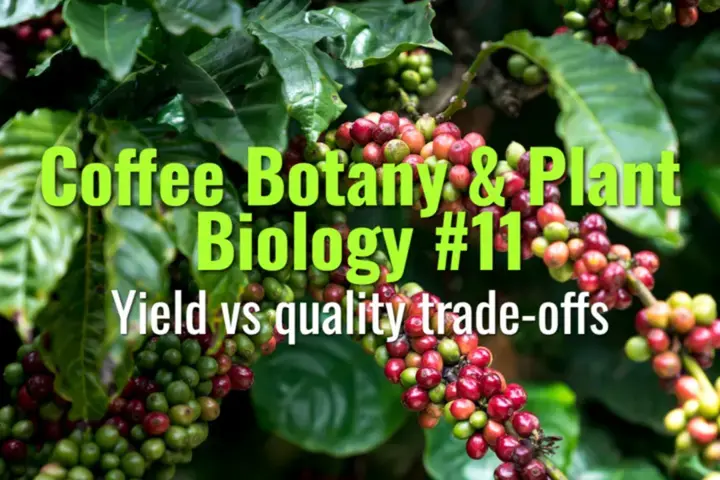Yield vs quality trade-offs
This topic explains the natural and management-driven trade-offs between maximizing coffee yield and achieving high cup quality, and why farmers, buyers, and consumers must balance these competing priorities.
- Coffee Basics Nerds
- 2 min read
Article 11 of 12 in Coffee Botany & Plant Biology/

The Yield–Quality Balance
- Yield focus: Maximizing cherry production per hectare often involves high-density planting, heavy fertilization, and mechanized harvesting.
- Quality focus: Producing specialty-grade coffee emphasizes selective picking, slower cherry maturation, and terroir expression—often at the expense of maximum yield.
Factors Influencing the Trade-Off
1. Genetics
- High-yield varieties (e.g., Catuaí, Castillo): Developed for disease resistance and productivity, sometimes sacrificing complexity of flavor.
- Heirloom or specialty varieties (e.g., Gesha, SL28): Lower yielding but capable of exceptional cup quality.
2. Environment
- Low altitude, warm climates: Higher yields, but faster maturation produces less dense beans with simpler flavor.
- High altitude, cooler climates: Lower yields, but slower ripening enhances sugar accumulation and complexity.
3. Farming Practices
- Yield-oriented systems:
- Full sun exposure.
- High fertilizer and pesticide use.
- Strip or mechanical harvesting.
- Quality-oriented systems:
- Shade-grown for slower maturation.
- Selective hand-picking of only ripe cherries.
- Careful fermentation and drying.
4. Economic Considerations
- High-yield farms: Provide stable income at lower margins per unit, often for commodity markets.
- Specialty-focused farms: Lower volumes but higher prices per pound. Greater risk due to market fluctuations and labor demands.
Trade-Off Examples
- Brazil (commodity Arabica & Robusta): High-yield mechanized production dominates global supply.
- Ethiopia (heirloom Arabica): Lower yields but distinctive flavor complexity fetches premium prices.
- Honduras & Colombia: Balance productivity with quality through improved post-harvest processes.
Climate Change Impact
- Rising temperatures and erratic rainfall may push farmers to favor yield over quality to survive economically.
- Breeding programs aim to combine resilience + productivity + flavor, but trade-offs remain.
Lasting Importance
Yield and quality are two ends of a spectrum:
- High yield ensures farmer survival and affordability for consumers.
- High quality drives specialty markets, consumer appreciation, and cultural value.
Sustainable coffee systems require finding a balance, ensuring farmers earn enough while preserving the diversity and excellence that make coffee unique.
You might also like:
- Tags:
- Lasting Importance
- Cup Quality
- High Quality
- Specialty Markets
- Specialty Grade
- Climate Change
- Disease Resistance
- High Altitude
- Flavor Complexity
- Post Harvest
- Arabica Robusta
- Lower Yields
- Terroir Expression
- Yield Quality
- High Yield
- Grade Coffee
- Factors Influencing
- Trade Offs
- Higher Yields
- Sustainable Coffee
- Selective Picking
- Breeding Programs
- Ripe Cherries
- Higher Prices
- High Density
- Cherry Maturation
- Low Altitude
- Premium Prices
- Slower Maturation
- Coffee Unique
- Balance Yield
- Rising Temperatures
- Erratic Rainfall
- Sun Exposure